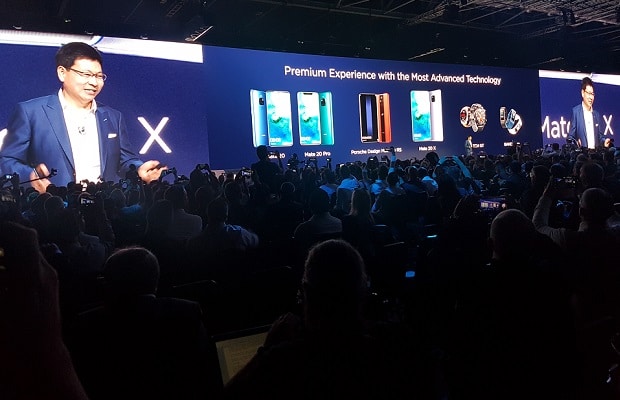
Launched yesterday in London under the strapline “A Higher Intelligence”, the flagship Huawei Mate 20 Pro marks a step-up for the phone maker, shedding it’s mid-range price image with a €1049 retail price that puts it on the same level as the iPhone X and Samsung Galaxy Note 9.
Unveiling the new phones, Huawei CEO Richard Yu outlined some key features that differentiate the smartphone from it’s competitors, including 3D modelling that can turn any real-life object into an animated AR avatar on your phone’s screen. The avatar can interact with the physical world and also new users which enter the screen. The video below was produced on-stage during the launch.
Toy panda was scanned and came to life on stage at #HuaweiMate20Pro launch. #IOT and #AugmentedReality advancements opening up new marketing opportunities #AI #DigitalMarketing @Huawei pic.twitter.com/03IYqz8PbO pic.twitter.com/QHT7jRcjB3
— Digital Intelligence (@DigiAcademy) October 16, 2018
Other standout features include reverse wireless charging (letting users charge other devices without the need for cables) a camera that can calculate the nutritional content of food on screen and AR shopping in partnership with over 200 retailers.
Neat take on how AR can help ecommerce. #HuaweiMate20Pro camera can scan goods. Users can buy online via holding down on camera screen. Partnership with over 200 retailers. #ecommerce #onlineretail #AugmentedReality #ar pic.twitter.com/osmkfwxWip
— Digital Intelligence (@DigiAcademy) October 16, 2018
The company was keen to emphasise the phone’s AI features and three lens camera. Machine-learning techniques are used to automatically select the best lens for each shot and to offer new effects, including the selective colourisation of video images in real time.
The phone is also being pushed as a productivity tool, and business users are being targeted by the ability to wirelessly link the handsets to Bluetooth-enabled screens for presentations.
In terms of security, the Pro model offers both a fingerprint sensor beneath part of its screen as well as a depth-sensing facial scanner.
Huawei also showed off a new mode called “3D modelling calorie calculation” that allows owners to track calorie estimates by using the camera application on foods. It showed off a demonstration of the Mate 20 Pro counting calories simply by using the sensors on the hardware’s rear.
See below for an example of how the phone can detect an apple and judge its nutritional content in real time:
Impressive new features at #HuaweiMate20Pro launch. Reverse wireless charging, 3D AR modelling and calorie counting camera! #ArtificialIntelligence #AugmentedReality @Huawei #AR #AI pic.twitter.com/3zeKwq15ZM
— Digital Intelligence (@DigiAcademy) October 16, 2018
Ditching Android Wear for a sleeker smartwatch
Huawei has previously used Android Wear for its watch range, but its latest companion device, the Watch GT, will use its own operating system. The company said the decision to use Lite OS had been taken in part to maximise battery life.
Android dominates the smartphone market, accounting for about 85% of all shipped handsets, according to IDC. However, its dominance did not extend to smartwatches. None of the five top-selling smartwatch brands currently uses Wear OS and it is installed on only 10.3% of all smartwatches shipped within the July-to-September period in Western Europe, according to IDC’s data.
Instead, Apple, Fitbit, Samsung and Garmin are among those to have adopted proprietary platforms. Now, Huawei is doing the same for its Watch GT.
The watch is compatible with both iOS and Android handsets. One benefit of offering more limited abilities was that the Watch GT’s price was lower than its predecessors – between €199 (£174) and €249, depending on the design.
“One more big thing”
Many of the details had leaked in advance, but the company did have one big surprise: the Mate 20 X. The model has a 7.2in (18.3cm) display – larger than some tablets – a companion stylus and a 5,000mAh battery.
In addition, the device has a snap-on games controller and is being pitched as an alternative to the Switch, with a longer battery device than the Nintendo hybrid gaming console.
The basic model of the Mate 20 will cost €799-€849, the Pro model €1,049, and the X €899.
